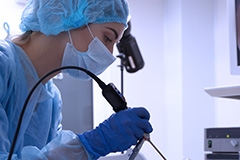The Hysteroscopy View from the Inside
Medically Reviewed by Merritt King, III, MD
When your Gynecologist needs to look at your uterus, they are likely using a long, thin tube smaller than a straw to look for polyps or treat other problems in your uterus.
“Hysteroscopy enables us to look at the cervix, the openings of the fallopian tubes and inside the uterus,” says Merritt King, III, MD. “It’s a great diagnostic tool and can be used to treat a wide range of health issues.”
A hysteroscopy can be done in a physician office or at the hospital.
USES FOR HYSTEROSCOPY
A hysteroscope has a camera on the end transmitting images to a video screen that your OB/GYN can view to look for or treat problems. Small tools or instruments can be placed in the tube to snip tissue, heat or freeze tissues and remove destroyed tissue.
The hysteroscopy can be used for:
- Finding and removing polyps.
- Diagnosing thickening of the lining or abnormal formations in the uterus.
- Treating irregular periods or heavy bleeding with an endometrial ablation.
- Remove scar tissue, adhesions from surgery or take a sample biopsy.
- Look for the cause of a miscarriage.
From a timing perspective, your OB/GYN will see the best view inside your uterus during the week right after your period.
Your physician will gently place the thin tube through your vagina and cervix into the uterus. They may expand the womb with a carbon dioxide, another inert gas or fluid, improving your doctor’s field of view. Be sure to tell your OB/GYN if you are or could be pregnant as the procedure might harm the developing baby.
AFTER YOUR HYSTEROSCOPY
Hysteroscopy can be performed with local anesthesia, and you can go home shortly afterward. With general anesthesia, you may need a few hours of rest before heading home. In either case, don’t drive yourself immediately after the procedure.
You may experience some bloody discharge and mild cramping for a few days. Your OB/GYN might prescribe some pain medication or simply recommend you take over-the-counter pain relievers, such as ibuprofen or acetaminophen.
Sources include: McLeod Health, American College of Obstetricians & Gynecology, Harvard Health Publications, National Institutes of Health
-
McLEOD REGIONAL MEDICAL CENTER FLORENCE
843-777-2000 -
McLEOD DARLINGTON
843-777-1100 -
McLEOD DILLON
843-774-4111 -
McLEOD LORIS
843-716-7000 -
McLEOD SEACOAST
843-390-8100 -
McLEOD CHERAW
843-537-7881 -
McLEOD CLARENDON
803-433-3000



-
McLEOD REGIONAL MEDICAL CENTER FLORENCE
843-777-2000 -
McLEOD DARLINGTON
843-777-1100 -
McLEOD DILLON
843-774-4111 -
McLEOD LORIS
843-716-7000 -
McLEOD SEACOAST
843-390-8100 -
McLEOD CHERAW
843-537-7881 -
McLEOD CLARENDON
803-433-3000
 Find a Doctor
Find a Doctor  Locations
Locations  Services
Services 